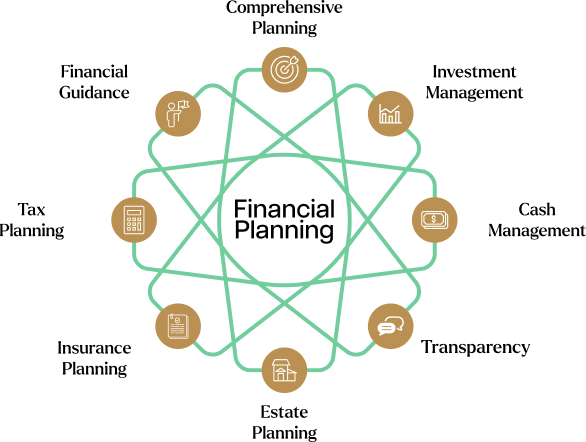January is the perfect time to start fresh and plan ahead for 2025. From ongoing changes in the market to the recent U.S. Presidential Election, there is a lot for both individuals and business owners to consider when reviewing their financial plans. From refining your investment strategies to ensuring your estate plan is up to date, a comprehensive new year financial checklist and review can uncover opportunities to strengthen your financial foundation. In this blog, we’ll discuss steps you can take to protect your wealth in the new year.
Because your goals act as the foundation for your wealth plan, the new year financial planning checklist is the perfect time to determine if anything needs changing.
Ask yourself a few of these questions: Are you on track to achieve your short- and long-term objectives? Do you need to adjust savings targets, diversify your investments, or reprioritize your spending? Reassessing your goals annually ensures you remain focused, intentional, and adaptable as you navigate the markets.

Although estate planning may seem like it’s only beneficial for those with significant net worths, we’d argue that it is important for everyone to regularly review (or establish). Life changes—such as marriages, divorces, births, or deaths—can impact your wishes, while shifting tax laws may create new opportunities or challenges. While going through your new year financial planning checklist, it may be in your best interest to revisit your estate plan to ensure it reflects your current circumstances and goals.
At BIP Wealth, we consider a wide range of factors when helping our clients plan their estate—from their unique financial goals to Power of Attorney and Healthcare Directives. Together, we’ll assist with your annual review to make sure you minimize your tax bill and help create generational wealth for your family.
While investing is a long-term way to build wealth, it is important to review your portfolio with your wealth manager when going through your new year financial planning checklist. Maintaining the right mix of investments such as small vs. large-cap investments, exchange traded funds (ETFs) vs mutual funds, and private vs. public investments, can help ensure you have a diversified portfolio to weather market fluctuations. During your new year financial planning, you can ensure your investments properly match your financial goals and are risk-tolerant. Rebalancing your portfolio can help restore the intended balance between stocks, bonds, and other asset classes, allowing you to manage risk effectively.

One of the best ways to build long-term wealth is through tax-advantaged accounts, such as 401(k) plans. These accounts enable your money to grow over time without the burden of hefty annual tax bills. In fact, regulatory changes in 2024 allowed investors to commit more money than ever to their plans, ensuring more wealth grows tax-advantaged.
For families, don’t overlook the power of Health Savings Accounts (HSAs), too. These accounts provide a triple tax benefit: contributions are tax-deductible, earnings grow tax-free, and withdrawals for qualified expenses are tax-free.
If you have children who are planning on going to college, 529 plans are another great option to consider when going through your new year financial planning checklist. By utilizing accounts like these, you can fortify your wealth for the long term.

If you’re a business owner who offers or is looking to offer 401(k) benefits to your employees, it is not a set-and-forget type of strategy. One of the most important small business new year checklist steps is to benchmark your 401(k) plan. Why is this important? This can help you evaluate the costs of your plan and potentially find ways to reduce your tax bill. During the benchmarking process, your financial advisor will help you identify new investment opportunities to meet both your goals and the goals of your employees.

Finally, consider whether you’d like to set money aside for charitable contributions when going through your year-end financial checklist, as they can offer more tax benefits in the new year. You can also take advantage of the annual gift tax exclusion, which allows you to gift up to $18,000 (for 2024) per recipient without incurring gift taxes. If you’re married, you can double this amount by gifting jointly. This is an excellent way to transfer wealth to the next generation while minimizing taxes.
If you’re looking for holistic wealth management services like you read about above, be sure to reach out to our team. You can also check out our resources hub to learn more about the latest topics in the financial world.
It is important to establish a new year financial planning checklist that helps you identify financial planning opportunities, new investment ideas, and ways to minimize taxes. This can help you grow your wealth over time while losing as little to tax bills as possible.
A new year financial planning checklist can help you ensure your goals are being met and that your financial plan is sound.
Yes! For individuals, families, and business owners, consulting a financial advisor here at BIP Wealth can be a great way to simplify the process. Think of our team as your Personal CFO.
In life, things often change in a heartbeat. Unexpected life events can have serious financial consequences if not planned for. Whether it’s a medical emergency, job loss, or natural disaster, being financially prepared for life’s unexpected events is essential. The right planning can make dealing with unexpected life events less stressful, ensure you have proper cash flow, and even protect your wealth in the long term. In this guide, we’ll break down the importance of understanding unexpected life events and how to best plan for them.
Before we dive into strategies for dealing with unexpected life events, let’s first establish what situations you should financially plan for and why they’re important.
Although it is not easy, have you ever imagined a scenario in which a loved one suddenly passes away? What would be your financial plan? You may be left with a large inheritance. You may also have not been the main financial planner of the family. How would you go about accessing funds in a bank account or trust fund, for example? Without proper estate planning, which we’ll discuss later, you could be left in a financial situation that is tough to navigate.
Divorce can be a financially destabilizing event, often requiring the division of assets, legal fees, and more. When you factor in wealth, you must consider the complexities that come with dividing assets, such as real estate holdings, investment portfolios, and business interests. So, how can you best navigate this unexpected life event? For starters, a robust financial plan can be a major asset in helping smoothly navigate the significant life transition that comes with a divorce. It’s crucial to assess the impact of asset division on your long-term financial goals, including retirement planning and estate planning. Additionally, understanding the tax implications of asset transfers can help you strategize effectively to protect your wealth.


Disabilities caused by illness or injury could strike at any time. Financial planning for this unexpected life event can help those affected maintain the best possible standard of living, even in the event of lost income or wages. While you may have significant assets, ensuring that you have enough liquid funds to cover the immediate expenses of an unexpected life event is important to consider. When assessing your investment strategy, ensure a portion of your portfolio is easily accessible.
Did you know that 50% of all business transactions are involuntary? Disagreements between business partners can potentially threaten the business’s future, and therefore your personal financial goals as well. That’s why it’s important to have a detailed buy-sell agreement in place that outlines the terms under which a partner’s share of the business can be sold or transferred, preventing potential conflicts, ensuring business continuity, and protecting your legacy.
Economic downturns, natural disasters, and personal crises like job loss or major health issues can cause financial distress and unexpected cash flow needs. This can be mitigated by proactive measures that allow you to access capital when you need it most. So, let’s discuss ways that you can properly plan for unexpected life events.
When unexpected life events occur, a solid financial plan gives you more than just peace of mind. For many, it is the difference between having the right amount of money in place and not being able to properly pass wealth down to their families.



If you’re a business owner, ask yourself some of the following questions: Am I prepared to retire? Who will succeed me in leading the business? Do I need any support from my financial advisor? A comprehensive review of your business plan could be a great way to avoid any financial pitfalls caused by an unexpected life event such as death or disagreement.
On top of this, it is important to ensure you’re properly bankrolled for your retirement years. This will help you and your loved ones access money in the event of any unexpected life events which may occur in your later years.
Another great strategy for staying one step ahead of unexpected life events is estate planning. This is a crucial part of any long-term financial plan. It involves creating legal documents such as a will, trusts, and power of attorney, which provide clear instructions on how your estate’s assets are to be distributed.
Without an estate plan, your assets could be subject to lengthy probate processes, potentially causing financial strain and uncertainty for your loved ones. On top of this, you may be paying more in taxes on your estate than you could with the right plan. For example, passing down certain assets to loved ones before death could help you receive different tax breaks.
It is important to regularly review your estate plan with your BIP Personal Wealth Advisor to ensure it remains up-to-date at all times.


In some cases, insurance coverage can be the best way to deal with unexpected life events. Imagine a scenario such as a car accident or house fire. Without proper insurance coverage, the financial burden could be life-altering. Imagine if you and your family lost a vacation home to flooding, for example. Insurance could be the safety net that protects you and your family from significant financial loss due to unexpected expenses.
Consider life insurance in addition to traditional coverage such as home, auto, and health. If you’re the main earner of your family, life insurance can help keep your loved ones taken care of in the event of your unexpected passing or injury.
On top of the strategies listed above, planning for life’s unexpected events can be difficult alone. At BIP Wealth, our holistic and empathetic approach to financial planning ensures that every client’s financial needs are handled with personalized care. From inheritance management to estate organization to financial education, we help individuals, families, and businesses navigate the waters of unexpected expenses and life-changing events—whether you’ve recently lost a loved one, won the lottery, or sold a business. Through expert guidance and risk management, our team of experienced financial advisors will help keep your hard-earned assets protected under any circumstance. To learn more about our team or speak with an advisor, feel free to contact us at any time.
Unexpected life events include things such as injury, divorce, disagreement, and more. Financially, these events can be life-altering.
To best prepare for unexpected life events, it is important to have a financial plan in place ahead of time. This plan can include insurance coverage, income diversification, and estate planning to ensure you and your loved ones can access funds in times of need.
Those who assume unexpected life events will not occur to them tend to be the hardest hit. It is important to assume you will need financial support at certain times of your life, even if you never end up needing the help.
Examples of life-changing events include death, divorce, auto accidents, and plenty more. These events could bring financial and emotional stress.
This communication contains general investing information that is not suitable for everyone and is subject to change without notice. Past performance is no guarantee of future results and there is no guarantee that any views and opinions expressed will come to pass. The information contained herein should not be construed as personalized investment advice, tax advice, or financial planning advice, and should not be considered a solicitation to buy or sell any security. Investing in the stock market and the bond market involves gains and losses and may not be suitable for all investors. Indices are not available for direct investment.
Author: Charles Crowley, CFP® AIF®
If you’re a small business owner, chances are you’ve thought about your employer 401(k) offering recently, especially if your business has grown. With more employees comes more responsibility to help them prepare for their retirement years. So, maybe you’re looking to optimize your current offering. Or, perhaps you’re looking to set up a 401(k) plan for your small business for the first time. How do you set up a 401(k) plan? What are the benefits of a 401(k) for your employees? And how much might it cost to offer one? In this blog, we’ll break down everything from helpful tips to follow when getting started to which states require employers to offer a 401(k) plan.



Before we discuss setting up a 401(k) plan for your small business, let’s quickly refresh on what they are. Simply put, a 401(k) is an employer-sponsored retirement plan. Employees have the option to invest a certain amount of their weekly, bi-weekly, or monthly earnings before taxes are taken out. In 2024, the IRS set a limit of $23,000 per fiscal year. There are even recent rules that give investors the power to force $76,000 into a tax-free status. This allows employees to build their wealth over time tax-free if their investments perform well. There are three main options for small business owners to decide from:
As a small business owner, the chance to offer an employer 401(k) plan is a great way to attract and retain top talent in the workforce. For job seekers, a robust 401(k) for employees can contribute to their long-term financial security, potentially reducing turnover rates. On top of the benefits of a 401(k) for employees, setting up a 401(k) at your small business can bring many tax breaks, including the deduction of employer contributions and company matches, saving you money in the long term.


Although setting up a 401(k) plan for your small business can be a win-win for you and your employees, only a certain number of U.S. states require it. If your business currently operates in California, Connecticut, Illinois, Maryland, New Jersey, or Oregon, you will need to establish some form of a retirement plan for your employees. Anywhere outside of those six states, the decision is entirely yours.
Once you’ve decided to set up a 401(k) plan for your small business, there are several key steps to follow. From pre-planning to benchmarking, it is important to ensure you keep an active eye on your plan, as market conditions and other economic factors could shift at any time.
Employer 401(k) plans are designed to be flexible, so ask yourself which type of plan you want to offer. Do you want to go with a traditional plan? Do you prefer the safe harbor option? How much would you be willing to match when employees contribute? These are just a few of the questions you can ask yourself when planning to set up a 401(k) plan at your small business.
One of the most important steps in setting up a 401(k) plan for your small business is arranging a trust for the plan’s investments and assets. The trust will be required to have at least one trustee, so it is important to partner with an advisor or financial management firm like BIP Wealth that you trust.
Once you’ve established which 401(k) route you will follow, you must put together official documentation that will be provided to the IRS. This document should include information such as which employees are eligible, how you will match contributions, and more.
Once your employer 401(k) is up and running, be sure to market it to your employees. Share educational materials, answer any questions your employees may have, and discuss the benefits of participation. As a mutually beneficial offering, a higher participation rate could lead to higher tax breaks for your small business.

After setting up a 401(k) plan for your small business, you will have plenty of opportunities to optimize your plan. Through benchmarking, businesses evaluate and compare the performance of their 401(k) plans against industry standards and data. This can help you find areas for improvement and even cut costs.
This will vary depending on the number of employees you have, administrative fees, and more. It is safe to assume you will spend anywhere from thousands to tens of thousands of dollars to successfully offer a 401(k) plan.
If you’re considering setting up a 401(k) plan for your small business, start by establishing your preferred plan (traditional, safe harbor, automatic renewal, etc.).
A 401(k) is a great way for small business owners and their employees to build retirement wealth tax-free. Compared to other retirement plans, a 401(k) will only be taxed when money is officially withdrawn.
Are you an investor? Are you looking to start investing? Creating a holistic financial plan can be daunting for investors, especially those who may be new to the industry. Objectives and markets can change in a heartbeat, making holistic financial management and investment planning a crucial part of any successful portfolio. So, what directions can investors go in? What should they know?
In this guide, we’ll discuss everything from Roth IRA strategies to the differences between investment management vs. asset management. Let’s start by first analyzing your current financial plan and why it may be dangerous in today’s markets.
No two financial plans are created equal. While your main goals might look similar to someone else’s, their investment strategy may not fit your unique financial situation. There are five main aspects to consider when first analyzing your financial management, and it all starts with planning—or struggling to plan—for the future.
Rewind five or ten years. Did you know then what you would be making today? And that can include your salary, investment returns, or any other form of income. An issue some investors may run into is that their current financial management assumes that they will continue to make a healthy amount of money. If your income suddenly slashes, it could seriously impact your retirement. So, to counteract this, it is important to establish what your “worst-case” scenario is. This can help you and your financial advisor create multiple plans of action to solidify your retirement goals.
When you first began investing, did you consider the outside costs that come with owning assets such as stocks? This is another mistake that is easy for new investors to make when considering their financial management strategies. For example, you could end up paying 2% or more in total investment expenses if your plan assumes that there are zero investment expenses out there.

Do you make this common financial management mistake? Your stock portfolio gained 20% in the previous fiscal year and you decide to sell most of it off at reposition. With a 4-5% tax hit, that 20% will look more like 15% when it is all said and done. Short-term gains are taxed at a higher rate, so it is important to consider the financial impacts of taxes before you decide to sell a large chunk of your investment portfolio.
For older investors, social security could be a great way to have a fantastic retirement. You paid your dues and now have the chance to be financially comfortable after you finish working. A lot of others, however, may not get this luxury. According to the 2023 Annual Report, the program may exhaust itself by 2033, meaning benefits may take a massive hit. For younger investors, it is important to plan for retirement without the traditional social security benefits we’ve known.
The final mistake investors make, by no true fault of their own, is not dying on schedule. The best financial management and investment strategies may plan for a life expectancy that you only have a 10% chance of achieving to account for the possibility of a longer life.
Now that we’ve identified some of the common pitfalls investors may face when building their investment strategies, let’s take a look at the core pillars of financial management. It all starts with establishing what the right plan is for your personal goals.



There are several ways you can manage your financial and investment strategies in today’s market. Two of these include investment management and asset management. So, which one is right for you? The answer depends on your ultimate investing goals.
Versus asset management, investment management involves handling financial assets and investments, going beyond mere stock trading to encompass budgeting, tax strategies, and more. It’s about strategically managing a portfolio to meet specific wealth accumulation goals through informed buying, selling, and holding based on market research and economic analysis. Pros include tailored strategies and active management.
Asset management, often used interchangeably with investment management, extends beyond securities to encompass real estate, commodities, and other assets. It focuses on understanding an investor’s goals for long-term capital growth, rather than short-term stock market gains. Asset management provides a holistic financial management experience, considering a wider array of holdings and needs.
If you’re looking to grow your wealth through financial management that encompasses primarily stocks and bonds, you may lean more on the side of investment management vs. asset management. However, if you already own many valuable assets such as homes, cars, and investments, asset management may be the way to go. If you’d like to talk with a trusted BIP Wealth advisor to learn more about these two strategies, please contact us.


Once you’ve identified whether you prefer investment management or asset management, it’s important also to consider the pros and cons of portfolio management and wealth management. These two strategies give investors two different paths for growing their wealth over time.
Compared to wealth management, portfolio management involves crafting a tailored financial plan considering risk and reward, aiming for high returns while managing overall risk. There are four types: active, passive, discretionary, and non-discretionary. Active management seeks to beat market benchmarks, while passive aims to match them. Discretionary managers make decisions independently, while non-discretionary managers require client input.


Wealth management, however, is a much more holistic financial management plan. This approach offers a broader spectrum of services compared to portfolio management, aiming to tailor strategies to clients’ diverse needs and long-term goals. It encompasses investment strategies, retirement planning, and more, ensuring holistic wealth growth and protection. Core elements include financial planning, asset allocation, asset management, estate, and tax planning.
Maintaining an investment strategy that can provide the best risk versus return is something that is always on the minds of investors today. So, how do Roth IRA strategies come into play? To start, they can help investors minimize the amount of tax drag, resulting in increased tax alpha. Effective Roth IRA strategies, if managed correctly, can potentially eliminate taxes. Since 1998, legislative changes have increasingly favored affluent investors in utilizing Roth IRAs. Investment managers can capitalize on these changes to enhance tax alpha for clients, often in collaboration with tax advisors. These strategies are generally low-risk and are welcomed by tax advisors aiming to minimize clients’ tax burdens.
To boost your Roth IRA strategies, the most basic technique is increasing the amount of money you put into it. As of 2024, the contribution limits are $7,000, with an additional $1,000 for folks over the age of 50.
Now that we’ve covered the basic aspects of financial management, let’s shift our focus to how to shape your investment strategies.
Defining what you want to accomplish through financial management is a critical first step to building a successful strategy. Do you have any existing assets you’d like to include in your financial management strategy? Are you looking for short-term gains? Long-term? These are just a few of the questions you should consider as you plan with your financial advisor as they help you get a clearer picture of your current and desired financial wealth status.


Once you’ve established your plan and set your overall goals, the next step is to figure out what you can and can’t afford to include in your financial management strategy. Budgeting helps you understand your income and expenses, giving you a clear picture of your financial situation. Budgeting for your investment strategy can also help you free up funds that can be directed towards investments, whether it’s in stocks, real estate, or retirement accounts.
Investing is not guaranteed to succeed. As a result, it is important to understand where you stand regarding risk. How much could you afford to lose if a stock price suddenly dips? Is your portfolio diversified to handle the rise and fall of stock prices? Managing risk can help investors maintain financial stability, both in the short and long term.
With the above information in mind, now it’s time to implement your investment strategy. There are a few critical steps to follow, the first being to have a critical eye when identifying your desired path forward.
To use a sports analogy, let’s think of your financial management strategy as a game of football. As the head coach of your wealth growth, it is important to think strategically about every move you make to ensure it aligns with your ultimate goals. At BIP Wealth, our advisors focus on factors such as investments, risk, and changing markets to quarterback your portfolio to success and act as your personal CFO.


We mentioned earlier in this guide that Roth IRA strategies can be the “holy grail” of tax-smart investing. By diversifying your investment strategy portfolio with retirement in mind, you can help establish long-term financial success for you and your loved ones.
Once you’ve nailed down your strategy, it is important to ensure your financial management strategy is robust and versatile. Set short and long-term goals for yourself, be specific in your objectives, and always account for taxes and inflation, as the two can dramatically affect your investment strategies at any time.
Keeping track of your financial management can be tricky. There are ways to streamline this process, however. At BIP Wealth, our proprietary platform—BIP ClientCare—helps clients manage and monitor your wealth. Talk to your advisor about how this tech platform can be utilized to help you.


At BIP Wealth, our trusted team of advisors helps clients achieve long-term financial success through holistic wealth planning that puts your personal goals and needs at the top. To learn more about our story and how we’re engineered to perform for you, be sure to get in touch with an advisor today. You can also check out our news and blog section to learn more about the headlines dominating the financial world today.
The main goal of financial management is to maximize the value of an organization or individual’s financial resources while mitigating risk.
Financial management, when done right, can help investors and organizations effectively manage their resources, make informed financial decisions, and plan for their financial future.
Financial strategies could include portfolio and wealth management, Roth IRA strategies, and even investment and asset management.
While answers will depend on your personal goals and financial situation, it’s good practice to budget for and track your investments over time.
Start by setting your goals and planning out a budget. From there, it’s all about creating the right investment strategy that sets you up for short and long-term success.
This communication contains general investing information that is not suitable for everyone and is subject to change without notice. Past performance is no guarantee of future results and there is no guarantee that any views and opinions expressed will come to pass. The information contained herein should not be construed as personalized investment advice, tax advice, or financial planning advice, and should not be considered a solicitation to buy or sell any security. Investing in the stock market and the bond market involves gains and losses and may not be suitable for all investors. Indices are not available for direct investment.
Authors: Charles Crowley, CFP® AIF® and Eric Cramer, CFP®, CFA®
As we’ve written, the Roth IRA may be “The Holy Grail” of investing. Because of this, investors should pay attention to the asset location strategy of their investments for 401(k) plans in 2024. Maximizing the after-tax return through a smart asset “location” strategy can yield meaningfully positive results, which is why Roth IRAs play such a critical role.
Roth IRAs, if handled properly, never create an income tax liability on investment returns, so they can be the perfect vessel for the most tax-burdensome elements of a diversified portfolio.
Going back nearly two decades now, working investors with a company-sponsored retirement plan have found themselves with a new option to consider: the “Roth 401(k)”. This feature, a staple in most plans but not necessarily all, allows a worker to designate a percentage of their elected salary deferral to receive Roth treatment. Rewind a couple of years and the Secure 2.0 Act of 2022 stipulated that this special tax treatment is additionally available for employer matching and non-elective contributions into the plan as well.
So, what is a “Roth 401(k)”? What are the eligibility requirements for Roth 401(k)s? And what is the 2024 401(k) contribution limit? Let’s break it all down.
Creating a 401(k) in 2024 presents businesses and employees with a number of different routes. Over time, employees can forgo the current period tax deduction in order to increase their assets such as catch-up contributions in the tax-free category. Investment returns in a retirement plan accrue to various funding sources, such as pre-tax salary deferral, post-tax Roth 401(k) salary deferral, and pre-tax employer contributions. The investment earnings of the plan that are pro-rated to the Roth source get the identical tax-free status, and the compounding effect means that earnings on the earnings will never get taxed.
With 2024 401(k) rules allowing $23,000 in salary deferral plus $7,500 in annual catch-up contributions for those aged 50 and over by the end of the year, the importance of these choices can overshadow the importance of any choices made about contributions to an IRA (which has much lower 2024 401(k) contribution limits).



But there is yet another important 401(k) 2024 contribution limit that investors should become familiar with; it’s applied to defined contribution plans and is called the Section 415(c)(1)(A) limit. In 2024 the Section 415 limit rose to a whopping $69,000! Let’s take a moment to break that number down.
How in the world, you might ask, can someone get that much money into a 2024 401(k) plan and beyond? You might be lucky enough to have an employer who is making a contribution to your plan, but even if you contributed $23,000 and your employer matched you dollar for dollar (and let’s be real, that’s rare), then that’s still only $46,000 for your 2024 401(k).
You may never have known that the tax code allows employees to make after-tax contributions to their employer-sponsored retirement plans over and above the normal salary deferral of $23,000. Your plan may not even allow it, but it should. The rules allow the employee to add money to their 2024 401(k) plan after tax (so no current period deduction is taken) until the total plan contribution equals the limit of $69,000. Factor in the additional catch-up contribution limit of $7,500, and you’ll find a grand total for older employees of $76,000!
In the past, this was probably not a good move. Remember that just like the Roth 401(k) contribution rules, the money being used for a post-tax contribution has already been taxed. But unlike the Roth contribution, which is also post-tax, the earnings do not retain the same tax status as the contribution. That means that your after-tax 2024 401(k) contribution will build up earnings that will eventually be taxed at your ordinary income tax rate when withdrawn. Annuities work like this, which is why they are often a bad tax move. If that money were simply invested in a taxable brokerage account, investments that grow in value could receive the preferential long-term capital gains tax treatment.
There was an important change to Roth 401(k) eligibility in 2010. Plans can allow after-tax contributions to be converted to the Roth status as an “in-plan Roth conversion”. Since the money has already been taxed, converting to a Roth carries no tax bill if done immediately. In the simplified case where an employee maxes out their 2024 Roth 401(k) deferral and then makes this after-tax contribution up to the limits, they could add $69,000 plus the $7,500 in catch-up contributions to their Roth investments.


Real-world practicalities that limit this approach are worth mentioning though. First, your plan may still not allow Roth contributions. Even if it does, it may not allow after-tax contributions, and if it does then it still may not allow in-plan Roth conversions. All these plan features for a 401(k) in 2024 may add a bit to the cost of administering your plan or it may simply be that your plan administrator hasn’t paid for the latest software upgrade to accommodate this level of complexity.
You should also remember that your ability to make after-tax contributions is reduced by your employer contribution to keep the total at $69,000 plus the catch-up contribution of $7,500, although most people don’t complain about getting free money from their employer. There is also the more complicated issue of a mandatory discrimination test applied to retirement plans called the ACP (Average Contribution Percentage) test, which is designed to make sure higher salaried employees don’t get too good of a deal.
If this leaves you a bit confused, don’t feel like you are alone. Many employers feel burdened by having to explain these options to their employees and just go for the less complicated approach. But as word gets out among financial planners and HR professionals in corporate America, demand for these 2024 401(k) features will rise.

You can be part of a wave of investors requesting access to these benefits if you contact your benefits department and ask some simple questions:
When you get the answers to these questions, give us a call. Our team of experienced 401(k) advisors can walk you through the choices you should consider.
For those investors who earn enough money to increase their savings rate substantially and hit their 2024 401(k) contribution limits, the long-term financial value of growing their Roth assets is a big deal. Investors who are lucky enough to have a pension plan, or who are worried about the income tax obligations of being forced to take required minimum distributions from non-Roth retirement assets once they reach age 70 1/2, should consider this a form of tax diversification that gives them needed flexibility. Even the self-employed and business owners who are looking at plan design issues should think about what this could mean for themselves (and their employees) and ask us for help.
One last note: all of the 401(k) limits mentioned above are for 2024, and one of the great things about the structure of these limits in our tax code is that they are indexed for inflation. That means that the numbers will change over time and keep up with the cost of living. Always check to see what the current numbers are. If you have any additional questions, feel free to contact us to speak with an advisor today.
The 2024 401(k) contribution limits allow for $23,000 in salary deferral and $7,500 in catch-up contributions.
The maximum amount you can contribute in 2024 is $7,500 if you are aged 50 or under. This limit increases to $8,000 for those older than 50.
In 2022, the Secure 2.0 Act passed, allowing for special tax treatment on certain types of 2024 401(k) plans.
In 2024, investors can contribute up to $69,000 ($76,500 if you are over the age of 50).
This communication contains general investing information that is not suitable for everyone and is subject to change without notice. Past performance is no guarantee of future results and there is no guarantee that any views and opinions expressed will come to pass. The information contained herein should not be construed as personalized investment advice, tax advice, or financial planning advice, and should not be considered a solicitation to buy or sell any security. Investing in the stock market and the bond market involves gains and losses and may not be suitable for all investors. Indices are not available for direct investment.
Authors: Charles Crowley, CFP® AIF® and Eric Cramer, CFP®, CFA®
The number of decisions a business owner must make year to year can be daunting. From finalizing budgets and strategic hiring to expanding operational capacity, it can be tough to prioritize all that has to be done. Evaluating the advantages of a 401(k) retirement savings plan is, unfortunately, one of the most impactful decisions often put on the back burner. If you are due to give your company’s type of 401(k) plan a closer look, there are five key aspects of 401(k) benchmarking to focus on to ensure it is set up effectively and efficiently.
In business, things will inevitably change—potentially at a fast pace. This is also true when comparing and benchmarking 401(k) plans. Companies grow, markets evolve, demographics shift, and needs ultimately expand. An important consideration is ensuring the business has not outgrown its type of 401(k) retirement plan offering. Perhaps your employee base doubled, and your current plan structure does not match that growth. There may also be a need to focus on benefits and enticements to attract/retain extraordinary talent for key positions. Maybe there was an increased turnover across your industry, and you want to ensure your retirement plan is set up to account for such trends. You may even find that the average fees for your 401(k) administration plan are no longer sustainable. Whatever your circumstances, the company retirement plan should be evaluated every 2-3 years to ensure the offering still fits the needs of your business and employees.



Arguably, the easiest facet of the 401(k) benchmarking phase is to evaluate the average fees for your 401(k) administration services and plan for the most cost-efficient type of 401(k) plan. Evaluating what best fits your needs can be overwhelming on your own. The sheer number of options, platforms, and features is vast, so it is important to seek assistance from an objective expert to help navigate it all. At BIP Wealth, we encourage business owners to focus on three things when comparing 401(k) plans:
Having excellent solutions to address these three questions when 401(k) benchmarking can reduce much of the operational headaches and time spent fixing issues down the road.
When we sit down with a business owner or leadership committee to discuss the company’s type of 401(k) retirement plan, one of the typical concerns shared is lack of participation. Far too often, employees are not making full use of the advantages of their 401(k) retirement plan and it is either because they do not understand the features of the plan or do not realize how participation benefits their future. Ensuring employees understand these aspects and are aware of the resources available to them when questions arise is a key responsibility of our team as a fiduciary to a 401(k) plan.


The most common feature of a 401(k) plan is, you guessed it, the investments. After all, the primary purpose of any type of 401(k) retirement plan is saving for retirement. However, this is a challenging piece of the 401(k) benchmarking puzzle. Consider this: what investment options are available within your current type of 401(k) plan? Do you feel they are diversified and sufficiently cover the differing risk tolerances, backgrounds, and needs of your employee base? It can be a tough question to answer and is also one of the largest risks for a plan sponsor – the fiduciary responsibility.
When 401(k) benchmarking, deciding how well your plan fits the needs of the participants is highly scrutinized in today’s regulatory world. This responsibility for most companies is often more appropriately managed by partnering with financial advisors, plan administrators, or industry experts. Doing so helps ensure the participants’ best interests are kept in mind while reducing costs and compliance risks for the sponsoring company.
Finally, and possibly the most important aspect to keep in mind when 401(k) benchmarking, is timing. There are key deadlines to consider whether you are altering your current type of 401(k) plan. Some deadlines are platform specific while others are mandated by the government. Nevertheless, it is critical to be proactive when enacting changes. This is especially important if you make changes requiring an adjustment to your plan documents. Give yourself and your team the needed time for appropriate due diligence when consulting with an expert who can guide you through these important decisions. This will help ensure you are not minimizing your options, forgoing benefits, paying higher than average fees for 401(k) administration, or simply locking your business into the status quo for another year. Each of these can have a monetary consequence in tow!


In conclusion, the insights above provide you with a few things to consider as you take a more detailed “look under the hood” when benchmarking your company’s 401(k) plan. If you are a business owner and would like to partner with experienced retirement experts on the evaluation of your plan, consider choosing BIP Wealth.
Click here to schedule a complimentary initial consultation with our team.
401(k) benchmarking refers to the process of evaluating and comparing the performance, fees, and features of an employer-sponsored 401(k) retirement plan against industry standards and peer group data.
To evaluate your company’s 401(k) plan, consider factors such as employee demographics, needs, and retirement goals. You will also want to compare 401(k) plans based on fees and overall cost.
401(k) benchmarking could help your business find areas to improve your existing 401(k) plan. This could save you time and money in the long term.
To start, assess the needs of your company and employees. Then, compare the costs of the 401(k) offerings available to make an informed, cost-effective decision.
This communication contains general investing information that is not suitable for everyone and is subject to change without notice. Past performance is no guarantee of future results and there is no guarantee that any views and opinions expressed will come to pass. The information contained herein should not be construed as personalized investment advice, tax advice, or financial planning advice, and should not be considered a solicitation to buy or sell any security. Investing in the stock market and the bond market involves gains and losses and may not be suitable for all investors. Indices are not available for direct investment.
For current and prospective investors in today’s diverse marketplace, there are a number of ways to manage your strategy and holdings. Two of these are investment management and asset management. If you’re unfamiliar with either of these, you’ve come to the right place. In this blog, we’re going to break down the two, including the scope and what an asset manager vs. an investment manager’s role will look like.
Because both strategies come with inherently unique paths to cultivating and growing wealth, we’ll also be examining the nuances between each that may align better with certain financial goals and aspirations. So, whether you’re an individual looking to invest for the first time, an individual looking to better manage your current financial investments, or an institution with vast resources, this blog will help shed light on which strategy may be the better fit for you. To start, let’s take a look at investment management vs. asset management.
To kickstart the investment management vs. asset management analysis, let’s first focus on the former. By definition, investment management is the handling of financial assets and other investments. It is important to keep in mind that this management strategy does not simply focus on buying and selling stocks, for example. It could also include strategies for budgeting, taxes, and more as well.
At its core, investment management is the professional art—and science—of managing a portfolio of securities, such as stocks and bonds, to ultimately achieve an investor’s specific goals. The primary goal is wealth accumulation through strategic buying, selling, and holding of these securities based on comprehensive market research, trend analysis, and a deep understanding of global economic factors.


Some of the pros you’ll find with investment management are the ability to create tailored strategies to your individual needs and goals and active management from your investment manager. At BIP Wealth, we focus on holistic wealth management and follow guiding principles such as expert insights and human connection, transparency and accessibility, and intelligent forecasting to help our clients navigate the road between risk and reward. To learn more, be sure to check out our holistic wealth management services page.
Asset management, though sometimes used interchangeably with investment management, encompasses a much wider range of wealth management. Think of it this way: Investment management can be considered a part of an asset management strategy, but asset management compared to investment management extends to a myriad of other tangible and intangible assets, including real estate, commodities, intellectual property, and sometimes even assets like artwork or vintage cars.
At its heart, asset management is also about understanding an investor’s unique needs and goals and focusing capitalizing on them in the long term. Because it encompasses so many more financial holdings, asset management vs. investment management may focus more on sustained long-term growth rather than short-term gains in the stock market, for example.
You’ll find that many of the pros to asset management are similar to investment management. Both asset management and investment management tend to give investors a much more holistic wealth management experience. Additionally, asset management may give investors access to alternative investments such as private equity and hedge funds. At BIP Wealth, our team of experienced financial advisors works to give our clients access to financial wealth opportunities that have historically been reserved for the ultra-wealthy.
Both asset managers and investment managers critical focus is on creating wealth for their clients. Now, there are some differences in the roles each takes on. Investment managers tend to focus specifically on the domain of stocks, bonds, and mutual funds. Their day-to-day may be more centered around market research, trend analysis, and portfolio balancing.
Asset managers, on the other hand, operate on a much broader canvas. They may put more focus into portfolio optimizations, strategizing with clients on the acquisition of, maintenance, and even the sale of a wide range of assets—from stocks to homes to luxury goods.
To put it simply, while both are stewards of wealth, their focal points differ. The investment manager is a craftsman, meticulously sculpting portfolios, while the asset manager is the mastermind, orchestrating an all-encompassing wealth strategy.


Because the journey of wealth management is a personal one, deciding which strategy may be right for you will take time—and be dependent on a number of factors. For individual investors who are looking to grow their wealth primarily through stocks and bonds, investment management may be the right way to go. For those who already own a high number of valuable assets, asset management may be the better choice. For larger organizations and businesses, the expansive and strategic purview of asset management also tends to align well, ensuring that assets are managed and grown cohesively over extended periods.
It is important to first consider your risk tolerance, as this can play a significant role in which strategy is right for you. If you prefer a more hands-on, active strategy with frequent adjustments, investment management’s active approach might resonate. Conversely, if you’re looking at long-term stability and diversified risk, asset management, with its wider asset base, might be more fitting.
If you have any questions or want to speak to one of our financial advisors, don’t hesitate to contact us. You can also check out our Resources to learn more about topics in the financial space, including portfolio vs. wealth management and why the Roth IRA is the “holy grail” of tax-smart investing.
What is the difference between asset management and investment management?
At its core, the difference between investment management vs. asset management is the scope of what is managed. Investment management tends to focus solely on stock and bonds while asset management can encompass a wider range of assets, such as homes and luxury goods.
Is an investment manager the same as an asset manager?
No. While the two share a similar role, asset managers tend to operate on a much broader canvas, including the management of a much wider range of financial assets, compared to investment managers.
Is asset management better than investment management?
It depends on what your financial goals and needs are. For individuals and organizations with many financial assets, asset management may be the better option. However, for individuals looking to start a stock portfolio, investment management may be the better choice.
This communication contains general investing information that is not suitable for everyone and is subject to change without notice. Past performance is no guarantee of future results and there is no guarantee that any views and opinions expressed will come to pass. The information contained herein should not be construed as personalized investment advice, tax advice, or financial planning advice, and should not be considered a solicitation to buy or sell any security. Investing in the stock market and the bond market involves gains and losses and may not be suitable for all investors. Indices are not available for direct investment.
Author: Eric Cramer, CFP®, CFA®
If you’ve ever gone through the financial and investment planning process, you might remember that it took some effort. But you might look back at that investment in time and feel some sense of satisfaction that you did something for yourself and your family. Unfortunately, investment planning may be extremely dangerous to your financial health. Here are the top five reasons why:
How many working people can look back a decade and say that they would have accurately predicted their current income level? Fortunes change, people lose their jobs, people get promoted, and the future is unknown for most of us. Because of this, future earnings become one of the biggest financial planning mistakes people may make. If your financial plan assumes you have a healthy income for decades into the future, but that doesn’t happen, do you expect your retirement lifestyle to be the same? Anyone more than ten years from their planned retirement needs to understand why a certain income figure was used in their plan, and they might want to make their income estimates extremely conservative just to test for problems with their plan. A good advisor may even run more than one plan, using different income levels, to examine the sensitivity of the plan to this input. Another technique used for people approaching retirement is to assume that all income ends in the current year. This helps establish what your “worst-case scenario” may look like and every year of additional income just makes things better.
Life expectancy is a tricky thing for anyone to predict. The best investment planning probably assumes a very long life expectancy, because outliving your money is the biggest risk most people face. Avoiding “superannuation” is the main motivation for many people to engage in investment planning, which is why some planners may suggest using a life expectancy that you only have a 10% chance of achieving. This doesn’t mean that this estimate is more accurate, it simply provides a more prudent way to think about how to plan.
If your investment planning doesn’t address the concept of investment expenses, then you may need to ask some questions. Another big financial planning mistake you can make is not taking into consideration what you’re paying in fees and even taxes on investments. For example, your stock broker may start to crank out financial plans that use index returns to predict portfolio returns. But the reality may be that your investment accounts become full of high-cost mutual funds, annuities, and other fee-laden investment products that may not be able to quickly adjust to market shifts. It isn’t unheard of for an investor to pay more than 2% in total investment expenses (and sometimes much higher) while relying on a financial plan that assumes there are zero investment expenses. For a $1 million portfolio, that’s $20K per year that doesn’t compound. If you don’t think investment expenses are a big deal then consider this: at the end of 2017, the average annual return of the MSCI ACWI IMI Global Equity Index for the prior ten years was only 4.97. And the Bloomberg-Barclays U.S. Aggregate Fixed Income Index return over that decade was only 4.01%. If your portfolio was paying an extra 2% in fees then, depending on your allocation, you may have barely kept half of your returns. At the end of the day, your investment expenses really do matter.
Taxes are boring, yes, so let us tease you with this idea: if you own an actively traded mutual fund, and it realizes short-term capital gains (from selling stock it owned less than a year), then the fund has to distribute those gains to you along with a tax on the investments. Your investment planning advisor may not see it coming, and there may be little you can do to stop it. To make matters worse, the distribution that hits your account will now be taxed at your highest marginal rate (because it’s a short-term gain). On top of this, distributed short-term capital gains cannot be offset with realized capital losses. So, if your super stock-picking mutual fund was up 20% in a big year, but sold most of its holdings to reposition, maybe you had 10% distributed to you at a tax cost of around 4-5%. Suddenly that terrific 20% turns into only 15%. The big pothole here is when a fund has a down year, but still sells some winners, and you pay investment taxes on a negative return! It’s happened before and it will surely happen again. Will you make this common financial planning mistake?
Some investors won’t need Social Security to have a terrific retirement, but for most of us, it will at least play an important role. And here’s the thing: Social Security has its risks. It’s not hard to be cynical about this program run by the Federal Government, but in the interest of giving respect where it’s due, the Trustees responsible for running this giant entitlement program write some of the best financial reports you will ever read. They have been telling us for years that there are major Social Security risks ahead, and it’s getting closer to reality. In the 2023 Annual Report, it was estimated that in all likelihood the program will exhaust itself by 2033. At that point, they estimate, benefits will have to be cut by 23% to match annual tax collections. We can’t know how our current and future politicians will address this problem, but if your investment planning isn’t assuming a cut to your currently legislated benefits, you may be counting on money that you will never receive.
At BIP Wealth, we focus on holistic wealth management to help our clients fortify long-term success and avoid the common financial planning mistakes you read about above. To learn more about our services, check out our What We Do page. If you’d like to get in touch with one of our wealth advisors, feel free to contact us!
How do I estimate future earnings?
Although it is very difficult to accurately predict your future earnings, it may be helpful to create more than one investment plan to determine what your financial situation could look like in different scenarios.
What is superannuation?
Superannuation refers to a retirement savings system in which individuals set aside a portion of their income during their working years to fund their retirement. It is commonly known as a pension or retirement fund.
What is an investment expense?
Investment expenses refer to the costs associated with managing and maintaining an investment portfolio. These could include advisor fees, taxes, and operating expenses.
When do you pay taxes on stocks?
Taxes on investments like stocks are typically realized when you sell them for a net gain or loss.
Is Social Security at risk?
In a recent estimation, it was said that Social Security could exhaust itself by 2033, resulting in a 23% benefits cut.
This communication contains general investing information that is not suitable for everyone and is subject to change without notice. Past performance is no guarantee of future results and there is no guarantee that any views and opinions expressed will come to pass. The information contained herein should not be construed as personalized investment advice, tax advice, or financial planning advice, and should not be considered a solicitation to buy or sell any security. Investing in the stock market and the bond market involves gains and losses and may not be suitable for all investors. Indices are not available for direct investment.